
Options for Improving Auto Fuel Economy in Georgia
1.1 Background
The main drivers for a revision of auto fuel economy (and conventional auto emission) policy in Georgia are proximity to EU vehicle markets and energy security concerns (all auto fuel is imported). The GFEI has worked in Georgia since 2010 with support from the European Commission and the Global Environment Facility, developing the Caucasus Fuel Economy Initiative. Led by the Caucasus Environmental NGO Network (CENN) with the assistance of the GFEI and its partner organizations, the years of discussions, a communications campaign, and specialized training at the regional and national levels have resulted in the publication of the first policy document on how to improve the energy efficiency of the car fleet in Georgia. By gathering and analyzing data from the Georgian car fleet (both imported new and used vehicles) from 2008, 2010, 2011 and 2012 using the GFEI Fuel Economy Policies Impact Tool (FEPIt) and the (upcoming) GFEI Feebate Simulation tool, a list of actions was produced that, will inform the development of a national auto fuel economy improvement plan in Georgia and help the country to reach a national average of 140g CO2/km by 2020 (as projected by FEPIt). Recommended actions include:
- Vehicle fuel economy labeling
- Used import restriction (in terms of vehicle age)
- CO2-based light duty vehicle acquisition and/or registration tax
- CO2-based light duty vehicle ownership tax
- Fuel quality standards (as a supportive measure for cleaner, more efficient technology)
1.2 Georgia’s Light-Duty Vehicle Fleet
Based on a Caucasus Environmental NGO Network and GFEI analysis , the overall population of Georgia’s imported LDV vehicles ranged in vintage from 1 to over 20 years old, with an average (mean) age of about 13 years and a most frequent (modal) age of 14 years. This is one of the oldest imported auto fleets in the world. The registration tax system in Georgia gives a significant incentive to buy older light duty vehicles as the tax is lower. The direct result is that light duty vehicles entering Georgia are older, with limited or no inspection to ensure they are safe and comply with minimum standards. Higher registration volumes occur for 12, 13 and 14 year old LDVs. Recent trends in 2011 and 2012 indicate that vehicles newer than 2 years old have increased their market share significantly to 7% of the new registrations in 2012, compared to 1% in 2008. Nevertheless, 2012 also witnessed a higher share of 16 years and older light duty vehicles, to 10%. Therefore, it appears the market is becoming divided into two as very new and very old light duty vehicles are both gaining market share. This trend would need to be confirmed in the near future as registrations data becomes available.
Vehicle Age Distribution, Georgia, 2008-2012
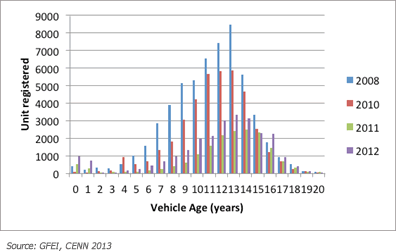
With regard to gasoline light duty vehicles the data revealed that light duty vehicle size is decreasing slowly in Georgia. Between 2008 and 2012 the total share of large gasoline light duty vehicles fell from 55% of total light duty vehicles to 39% of total light duty vehicles. Conversely, the share of small gasoline light duty vehicles increased from 7% to 11%. With regards to diesel light duty vehicles analysis of the data revealed that light duty vehicle size is increasing rapidly in Georgia. Between 2008 and 2012 the share of large light duty vehicles increased from 3% to 16%.
Overall, light duty vehicle size is getting smaller while engine size is getting bigger, showing that the downsizing effect on internal combustion engines has still to impact the Georgian market in the coming years. Small engines below 1.2 liters are still not popular and have a tiny share of the market. The registration tax system is also based on the engine size, showing that the fiscal lever on engine size does not seem to be working effectively.
Georgia LDV size evolution, by fuel type and engine size, 2008 to 2012
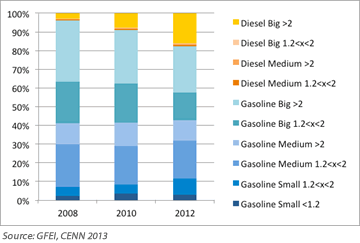
There is a clear trend of dieselization within the data, showing an increase in the number of diesel light duty vehicles from 4% in 2008 to 18% in 2012. This trend is not likely to change in the near future, as the countries of origin of the used light duty vehicles have a higher share of diesel light duty vehicles in their fleets. The evidence suggests that by 2020 one third or more of all new LDV registrations will be diesel.
Georgia fuel types of new LDV registrations, 2008 to 2012
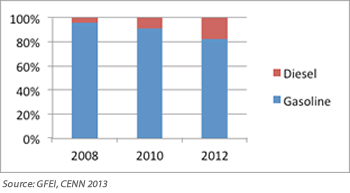
1.3 Status of LDV fleet fuel consumption/CO2 emissions
Georgia’s LDV fleet is characterized by an ageing fleet, primarily imported second-hand from Western Europe, Japan, and the USA, with a GFEI-calculated average fuel economy of 189 grams of CO2/km in 2012. This is one of the worst fuel economies of a fleet in Europe and well above the global average (as of 2011 the global fuel economy average for LDV’s is 167g CO2/km (7.2 Lge/100km) according to the latest GFEI global analysis). This situation is due to Georgia’s inefficient LDV legislation system, in particular its taxation regime for vehicle imports that does not incentivize cleaner, more efficient vehicles but rather encourages the purchase of older vehicles.
In addition to the high greenhouse gas emissions of these vehicles, the fuel quality in Georgia is poor, with a high level of sulfur (150 mg/kg and 200 mg/kg for gasoline and diesel respectively), benzene and aromatic hydrocarbons thus adding to the overall pollutant emissions. These issues are compounded by year-on-year increases in fuel consumption in Georgia; combined gasoline and diesel consumption in 2000 amounted to 230,000 tons, by 2011 consumption was 830,000 tons. All of this fuel was imported, leading to a significant financial drain on the country’s economy and macroeconomic vulnerabilities.
Average fuel economy and new vehicles registrations 2008, 2010
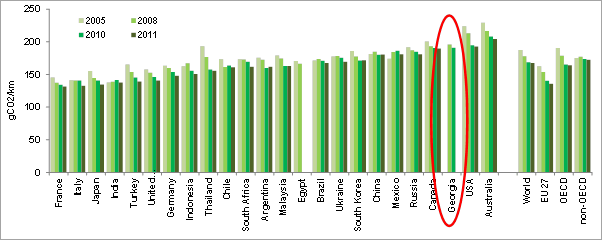
Assuming that the recommended fiscal and labeling policies are fully implemented, the GFEI FEPIt indicates that Georgia can expect to reach a fuel economy of 144 g CO2/km by 2020. The target suggested by the GFEI is 140 g CO2/km by 2020. This objective seems ambitious but realistic; by 2020, average new EU car fuel economy is expected to be below 100 g CO2/km, leaving Georgia further margin for improvement after 2020. However, if the status quo is maintained in Georgia then the GFEI FEPIt predicts that Georgia’s fuel economy will be 174 g CO2/km by 2020. Given that Georgia relies heavily on used imports from European countries, strong dieselization of the market is expected in the near future.
2.0 Regulatory Policies
2.1 National Standard
Georgia does not currently have a strategy, or specific policies, to improve or regulate auto fuel economy. However, fiscal policy (specifically registration and ownership tax) can be re-designed to support a more efficient fleet.
2.2 Test cycle type
None
2.3 Import restrictions
New Vehicles
None
Second Hand
None
2.4 Technology mandates/targets
None
3.0 Fiscal Measures and Economic Instruments
3.1 Fuel Taxes
N/A
3.2 Fee-bate
N/A
3.3 Buy-back
None
3.4 Penalties
None
3.5 Other tax instruments
There is currently no LDV ownership tax in Georgia. Therefore LDV owners in Georgia are not obliged to pay annual fees depending on the fuel efficiency of their vehicle. As there is no LDV inspection system currently in place in Georgia implementation of this tax is considered to be costly and logistically difficult by the government. Due to the planned implementation of vehicle testing standards in March 2015, such a tax may be considered to be more feasible from 2015 onwards.
3.6 Registration fees
The current taxation system for imported vehicles in Georgia is dual, and not linked to fuel economy. Instead, the tax varies according to the engine volume and age of the vehicle. Initially, and in accordance with clause 188 of Georgia’s tax code, cars are subject to an excise tax that is levied based on vehicle age and engine size:
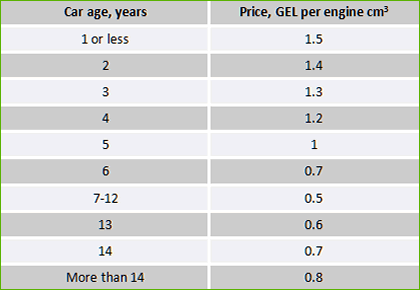
Given that the lowest rates of taxation are for vehicles between 7-12 years of age, the excise tax stimulates the import of older cars. And this is reflected in the distribution of vehicle age discussed above. In addition to the excise tax, according to clause 197 of the Georgian code, cars are subject to an import tax. When importing a car and additional sum of 0.05 Georgian Lari (GEL) per engine cm3 is added. An additional 5% of this initial amount is added for every year of the vehicle’s age; however, this tax contributes only a negligible amount to the total tax, and therefore does not sufficiently incentivize newer/lower emitting vehicles.
Tax applicable to new, 2001-2007, and pre 2001 vehicles in Georgia
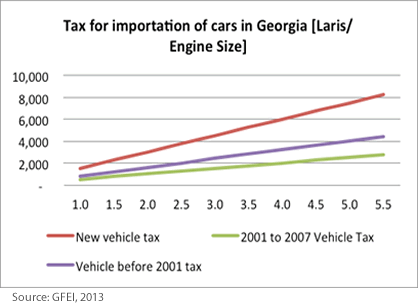
3.7 R&D
None
4.0 Traffic Control Measures
4.1 Priority lanes
N/A4.2 Parking
N/A
4.3 Road pricing
N/A
5.0 Information
5.1 Labeling
There is currently no labeling of vehicles or fuel economy rating system in Georgia.
5.2 Public info
None
5.3 Industry reporting
None
The text above is a summary and synthesis of the following sources
- White Paper On Options for Improving Automotive Fuel Economy in Georgia. Global Fuel Economy Initiative 2013.
- International comparison of light-duty vehicle fuel economy. Global Fuel Economy Initiative Working Paper #5, 2011. http://www.globalfueleconomy.org/Documents/Publications/wp5_iea_fuel_Economy_report.pdf
- International comparison of light-duty vehicle fuel economy: An update using 2010 and 2011 new registration data. Global Fuel Economy Initiative Working Paper #8, 2012. http://www.globalfueleconomy.org/Documents/Publications/wp8_international_comparison.pdf








